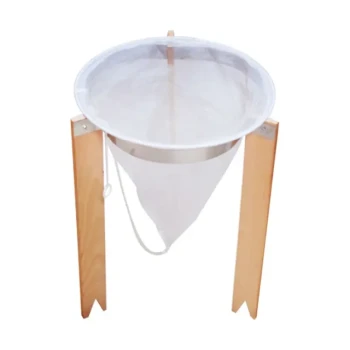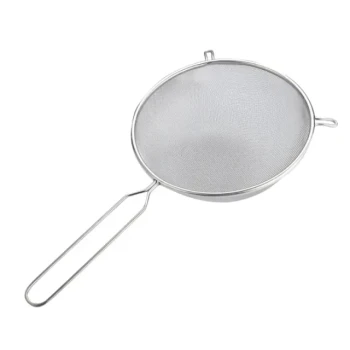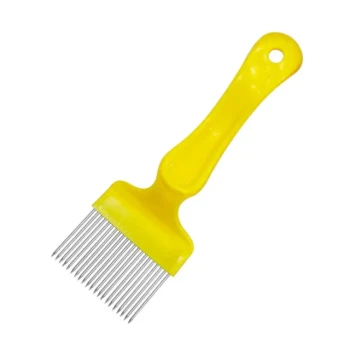For hobbyist beekeepers, the right honey filter size depends on your goal, but the process typically involves using multiple filters in succession. The standard sizes are 600, 400, and 200 microns, which are used to progressively remove debris—from large wax chunks down to fine particles—without removing the beneficial pollen naturally present in your honey.
The core principle of honey filtration is not to strip the honey, but to clean it. You should think of it as a multi-stage straining process, starting with a coarse filter (larger micron number) to catch big debris and moving to a fine filter (smaller micron number) for a final polish.
Understanding the Goal of Honey Filtration
For the small-scale beekeeper, the process is more accurately called straining, not filtering. Commercial filtering often involves high pressure and heat, which can remove pollen and alter the honey's natural state. Your goal is simply to remove unwanted debris while preserving the honey's quality.
What "Micron" Means
A micron is a unit of measurement equal to one-millionth of a meter. When discussing filters, the micron number refers to the size of the holes in the mesh.
A larger micron number (like 600) means larger holes, creating a coarse filter. A smaller micron number (like 200) means smaller holes, creating a fine filter.
Removing Debris, Keeping the Pollen
The primary purpose of straining is to remove visible impurities like wax cappings, wood splinters from the hive, and tragically, bee parts.
A common concern is accidentally removing beneficial pollen. However, the average pollen grain is about 25 microns in size. The finest hobbyist-grade filter is typically 200 microns, meaning its holes are far too large to capture pollen. Your straining process will not create pollen-free honey.
A Practical Guide to Each Filter Size
The most effective method is to use these filters in a tiered system, either by stacking them or using them one after the other. This prevents the finer filters from clogging up immediately.
The 600 Micron Filter (Coarse)
This is your first pass. Its large holes are designed to catch the biggest pieces of debris, like large chunks of beeswax and other major impurities that fall in during extraction. Using this filter first is essential to prevent your finer filters from becoming instantly clogged.
The 400 Micron Filter (Medium)
This is the workhorse of honey straining. After the initial coarse strain, the 400-micron filter will catch smaller bits of wax and other visible particles. For many beekeepers who prefer a more rustic, minimally-processed honey, this filter alone can be sufficient.
The 200 Micron Filter (Fine)
This is your polishing step. The 200-micron filter removes the finest suspended particles, resulting in exceptionally clear and sparkling honey that looks beautiful in a jar. Using this filter will produce the cleanest final product, ideal for gifting or selling.
Understanding the Trade-offs
Choosing your filtration strategy involves balancing clarity, speed, and effort. There is no single "best" answer, only the best approach for your desired outcome.
Clarity vs. Speed
A finer filter (like 200 microns) will produce clearer honey but will strain much more slowly and clog more frequently. Coarser filters are faster but leave more microscopic particles behind.
The Importance of Temperature
Warm honey is significantly less viscous and flows through filters much more easily. Straining honey at room temperature (or slightly warmer, around 80-95°F or 27-35°C) will make the process dramatically faster and more efficient, especially with finer filters. Never overheat your honey, as this can destroy its beneficial enzymes.
The Myth of "One and Done"
While you can use a single filter, you will get better and faster results by using at least two. Pouring raw, unstrained honey directly into a 200-micron filter will cause it to clog almost instantly, leading to immense frustration. A coarse pre-filter is always recommended.
Making the Right Choice for Your Goal
Your filtration strategy should align directly with the type of honey you want to produce.
- If your primary focus is maximum clarity and a professional finish: Use all three filters in sequence, starting with 600, then 400, and finishing with 200 microns.
- If your primary focus is a good balance of clarity and efficiency: A two-stage system using a 600-micron filter followed by a 400-micron filter is an excellent compromise.
- If your primary focus is minimal processing for a rustic, raw honey: A single pass through a 400 or 600-micron filter will remove the largest debris while leaving the honey in a more natural state.
By understanding the role of each filter, you can confidently produce clean, beautiful honey that meets your specific standards.
Summary Table:
| Filter Size (Microns) | Purpose & Role | Best For |
|---|---|---|
| 600 Microns | Coarse/First Pass: Removes large wax chunks and major debris. | Essential pre-filter to prevent clogging of finer filters. |
| 400 Microns | Medium/Workhorse: Catches smaller wax bits and particles. | A great balance for rustic, raw honey or as a final filter. |
| 200 Microns | Fine/Polishing Step: Removes finest particles for sparkling clarity. | Producing exceptionally clear honey for gifting or selling. |
Ready to Stock the Right Filters for Your Apiary?
Whether you're a commercial beekeeper managing large-scale honey production or a distributor supplying the beekeeping community, having the correct filtration equipment is crucial for efficiency and quality.
HONESTBEE supplies durable, high-quality beekeeping supplies and equipment—including a full range of honey filters and straining systems—through our wholesale-focused operations. We help commercial apiaries and distributors maintain a seamless honey processing workflow.
Let's discuss your specific needs: Contact our wholesale team today to find the perfect filtration solutions for your operation.
Related Products
- Professional Honey Filter with Tripod Support Stand
- Nylon Honey Strainer Square Filter Cloth for Honey Filters
- Professional Stainless Steel Honey Filter with Support Handle
- Professional Cone-Shaped Honey Filter with Reinforced Steel Ring
- Two-Stage Plastic Honey Filter for Buckets
People Also Ask
- What is the process of filtering honey? A Guide to Clean, Pure, and Market-Ready Honey
- Should I filter my honey? A Guide to Clarity, Crystallization & Quality
- Can raw honey be filtered? Unlock the Truth About Processing & Purity
- What are the benefits of filtering honey? Enhance Purity, Shelf Life, and Market Appeal
- How can contamination in filled honey be prevented? A 3-Step Strategy for Pure, Shelf-Stable Honey



















